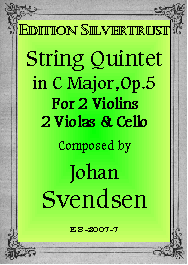Presents
Johan Svendsen
String Quintet in C Major, Op.5
For 2 Violins, 2 Violas & Cello
 Johan
Svendsen (1840-1911) was born in Oslo. His father was a music teacher and
Svendsen learned both the violin and clarinet from him. By the time he finished
school, he was working as an orchestral musician, and occasionally made short
concert tours as a violinist. In Lubeck, on one of his tours, he came to the
attention of a wealthy merchant who made it possible for him to study from
1863-67 at the Leipzig Conservatory. He began his studies with Mendelssohn's
favorite violinist, Ferdinand David, but problems with his hand forced him to
switch to composition which he studied with Carl Reinecke. Afterwards, Svendsen
worked primarily as a theater director and conductor. He achieved considerable
fame as the latter and, during the last 20 years of the 19th century, was
considered the leading Scandinavian conductor.
Johan
Svendsen (1840-1911) was born in Oslo. His father was a music teacher and
Svendsen learned both the violin and clarinet from him. By the time he finished
school, he was working as an orchestral musician, and occasionally made short
concert tours as a violinist. In Lubeck, on one of his tours, he came to the
attention of a wealthy merchant who made it possible for him to study from
1863-67 at the Leipzig Conservatory. He began his studies with Mendelssohn's
favorite violinist, Ferdinand David, but problems with his hand forced him to
switch to composition which he studied with Carl Reinecke. Afterwards, Svendsen
worked primarily as a theater director and conductor. He achieved considerable
fame as the latter and, during the last 20 years of the 19th century, was
considered the leading Scandinavian conductor.
All of Svendsen's chamber music was written while
he was at the Leipzig Conservatory, yet these works were not then, and should
not now, be considered student works. Svendsen was regarded, by general
consensus, as one of the most talented students then at the Conservatory. His
works won prizes and received public performances to acclaim. The String Quintet was completed in 1867 and published the
next year. The opening movement has a substantial Andante introduction
which builds tension and introduces the substantial main theme. Gradually,
almost imperceptibly, the Andante changes into an Allegro. A lighter
second theme has a Nordic sea flavor. The big second movement, Tema con
Variazione, is the Quintet's center of gravity. The theme is a pretty,
somewhat melancholy folktune. It is the magnificent treatment of this theme
given in the several superb variations which follow that has always attracted
attention and high praise. Our sound-bite Presents
the main theme, a powerful,
march-like variation and a lovely variation which is nothing less than a
mini-serenade. The finale, Allegro, is built around a dance theme,
perhaps a Norwegian folk dance. It becomes faster and faster while building in
tension. The lyrical and more gentle second subject also has Nordic tinges about
it.
The famous chamber music critic, Wilhelm Altmann, highly recommended this work to quintet groups, praising its lovely melodies, effective string writing and playability. We, too, agree and believe that they will find it highly enjoyable.
Parts $29.95